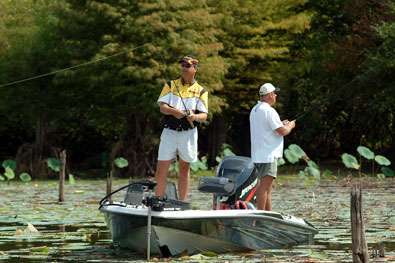
It's hot in the Deep South right now. I'm talking melt-the-asphalt-in-the-parking-lot, hot. Hot enough to fry an egg on the back of your neck hot. So hot that I've got "Southco" permanently branded on the back of my leg from sitting on those chrome latches that BassCat is so fond of. Frog time hot!
This time of year, I'm looking for the hottest, stillest, most miserable day you can find, and you should be, too. Those are the days that are perfect for big bass in the lily pads on hollow bodied frogs.
The equipment that you use for this type of fishing is critical. A heavy action rod with enough tip to be able to cast the frog long distances, a medium speed reel with enough power to winch a big fish out of the pad stems and 50- to 65-pound braided line are best. My personal preference is a Falcon Original 7-foot Carolina Lizard Dragger 1 with a Shimano Calcutta 200B and 65-pound Power Pro.
For the frog itself, I prefer the Snag Proof Tournament Series frog. To add weight, I'll use brass bells rather than lead weights. The great thing about the bells is the sound that they make as the frog comes across the top of the pads. It drives the bass wild! You can purchase bells at every craft store, and I keep a selection of sizes to vary the sound and weight.
When looking for the perfect pad field, think location, location, location. Kind of like looking for a good business location, you want a spot with a lot of traffic and a reason for the fish to be there. Creek channels, drop offs and intersections are the best areas. What you are looking for is something that brings the fish to a specific smaller area in what can be pretty massive areas of pads.
The bass are using the pads to feed, so you are also looking for baitfish in the area and especially for bream feeding in the same pad fields. If you are in an area where there is no activity, there aren't any bass there. Of course, the best sign is to hear bass feeding on the surface. I prefer smaller pad fields along a river, pad points and areas where two types of pads meet.
The strike is what this type of fishing is all about. The sound of a good strike is somewhere between someone throwing a cinderblock on top of your frog and a toilet flushing — definitely not for anyone with a heart condition. Nothing beats that sound!
When a bass takes the frog under, it's critical to wait before setting the hook. I always keep the rod tip high during the retrieve so that when a fish bites, I have to drop the rod tip before I can set the hook. This gives you a built-in delay and helps keep you from taking the bait away from the fish.
Once you're sure the bass has the bait in his mouth, set the hook hard and try to get him up on top. This is where the braided line with no stretch is really critical. Not only does it provide a better hook set, the braid will cut through most of the pads keeping the bass from tying you up. If you do get hung up in the pads, just keep pressure on the fish and go to him. Most of the time, the fish will stay hooked up until you get there.
Most fishermen new to frog fishing complain about the number of fish that miss the frog, but more times than not a fish that misses a frog will come back and hit again. After the initial strike, stop your bait and let it sit for a few seconds, then twitch it. If that doesn't work, reel in the frog and throw it back to the same spot. Bring it up to the hole made in the pads by the strike and stop it in the hole. Often it will take multiple casts to the same area to get the fish to bite again, but bass tend to stay in a very small area, and it's just a matter of getting them aggravated enough to bite again.
On one of the best days that I ever had fishing a frog, my partner and I caught a 5-bass limit that weighed 30 pounds, 7 ounces, and every one of those fish hit five or six times before we caught it. None of them moved more than 5 feet from the spot of the initial strike, and all but one of them came out of the hole made in the pads by the first strike. So patience and persistence are the keys to this type of fishing.
When the thermometer reads above 90, load up the ice chest with water, grab some sunscreen, put on your Costas and head to the lake. Nothing beats catching bass on top, and the pads offer the best topwater bite around. Maybe they should be called the frog days of summer!
Originally published July 2009




